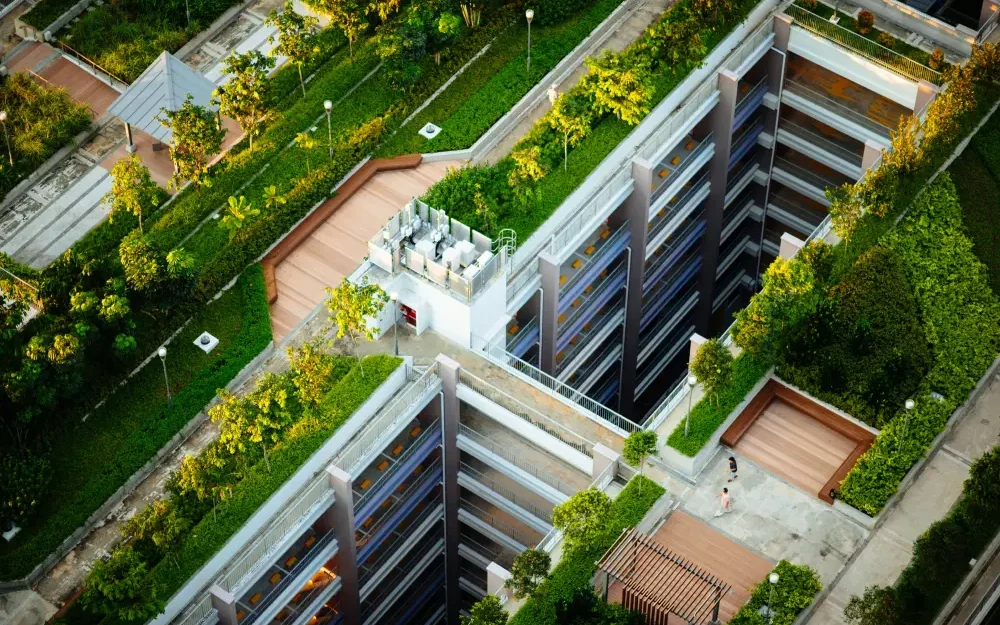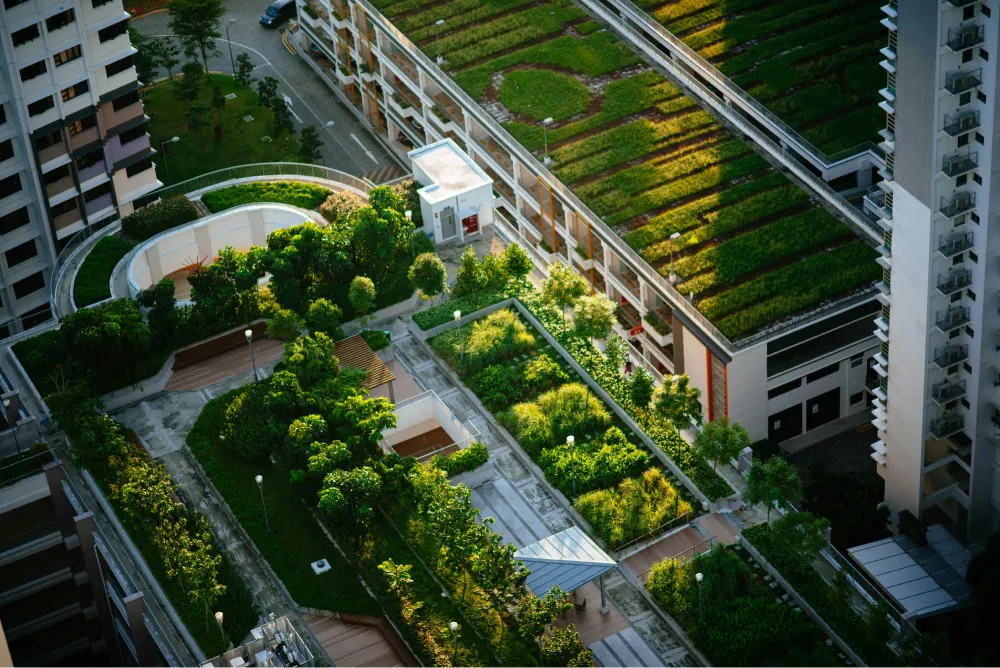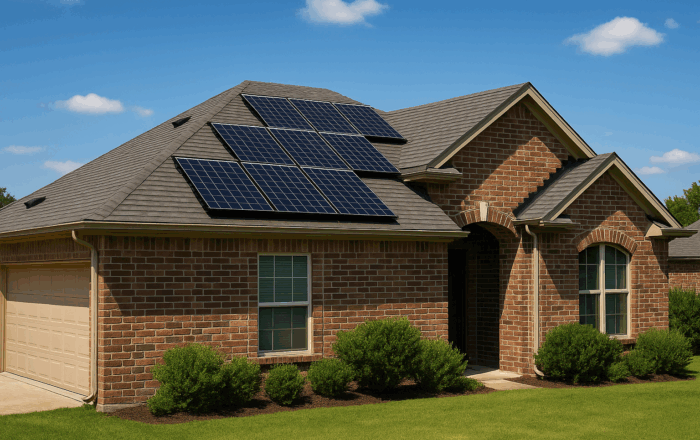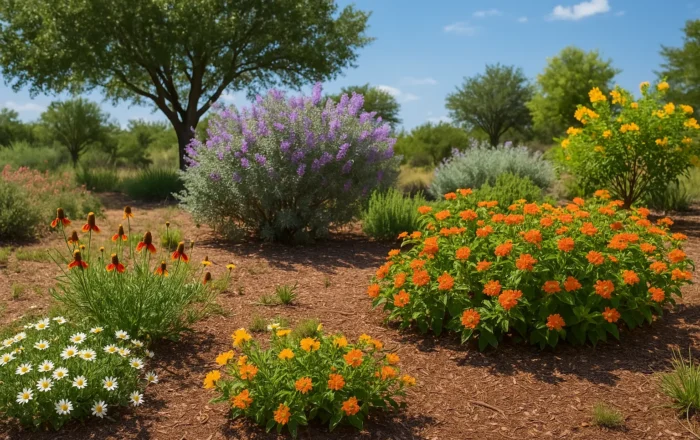Home Improvement Living in Texas
How Many Solar Panels Do You Need in Texas?
4 minute readHow to calculate the number of solar panels you need to power your Texas home
Home > BKV Energy Blog > All Posts > The Benefits of Green Roofs
6 minute read • Last update March 2024

A green roof, also commonly known as a living roof, is one that is either partially or completely covered in living plants or other vegetation. The greenery is planted on top of a growing medium and a waterproof membrane to keep water from entering the structure below. Many green roofs also include a barrier to prevent roots from growing into and damaging the building, as well as an irrigation system to ensure the health of the plant life and to bolster the waterproof membrane’s ability to prevent leaks inside.
Green roofs are considered a form of sustainable architecture that offer many benefits, such as environmental enhancement, energy savings, and social welfare. These eco-friendly structures are pivotal in reducing urban heat, managing rainwater, and increasing habitat for wildlife while offering tangible economic returns and bolstering community health.
Let’s dive further into the environmental benefits of green roofs.
Consider a typical city block on a hot summer day, with the sun blazing and concrete and asphalt absorbing the heat. This is how heat islands form.
Now envision that same block, adorned with green roofs on the buildings. The scenario changes dramatically. Green roofs are able to reduce local air temperatures in two main ways: providing shade and via evapotranspiration.
One study found that green roofs were up to 60 degrees Fahrenheit cooler than a typical black roof.
Green roofs can significantly enhance air quality. The vegetation on green roofs captures particulate matter and airborne chemicals, a process known as dry deposition. This process leads to significant reductions in particulate matter, contributing to cleaner air and less smog.
Moreover, green roofs contribute to the decrease of respiratory diseases and eye irritation by reducing levels of nitrogen dioxide and sulfur dioxide.
And let’s not forget about their role in combating climate change. Through carbon sequestration, the vegetation on green roofs stores carbon dioxide, a major greenhouse gas, which helps in reducing atmospheric CO2 levels.
In areas that receive a lot of rainfall, stormwater management and water conservation take on a crucial importance. Green roofs excel in these areas, offering the following benefits:
But that’s not all. Green roofs offer several benefits, including:
Green roofs are far more than just a layer of soil and vegetation atop a building, they are living ecosystems that can support a diverse range of plant and animal species.
Animals may include:
Plants often include:
The type of plants used on a green roof will vary by location and should be planted to suit the local climate.

The economic benefits of green roofs also warrant attention. They can more than double the lifespan of a conventional roof – from an average of 17 years to a striking 40 years. This extended life expectancy is a significant cost-saver in the long run. Here’s how green roofs extend the lifespan on your roof:
Green roofs also contribute to energy savings, leading to annual savings of about $0.023 per square foot of the roof’s surface. Additionally, cities offer incentives such as tax abatements, density credits, or loans to combat initial green roof cost, enhancing long-term economic savings.
Green roofs also help reduce energy bills significantly by helping regulate the indoor temperature of a space and decreasing the need to rely on heating and cooling systems.
Green roofs and solar panels are a perfect pair, commonly called biosolar roofs. The presence of vegetation on green roofs establishes a cooler microclimate, ideal for maintaining solar panels at their most efficient operating temperature. This reduced thermal stress on the solar panels also contributes to the lifespan of the solar systems.
Green roofs can also bestow a wealth of social and community advantages. They play a significant role in improving mental health by reducing stress and the impact of anxiety and mood disorders. They provide a necessary connection with nature in urban environments, offering calming effects that enhance well-being.
Moreover, green roofs have several benefits:
Like any construction project, installing a green roof involves several practical considerations.
In some cases, the factors may line up in a way that would make installing a green roof impractical.
The initial green roof investment can be substantially higher than the approximately $8,500 cost for a traditional shingle roof – the lifecycle costs of green roofs can undercut those of conventional roofs. This means that despite higher upfront costs, the long-term savings make green roofs a worthwhile investment.
The payback period for a green roof, including extended lifespan and reduced replacement costs, is around 6.2 years on a national average. This relatively short payback period, combined with the significant long-term savings, makes green roofs an economically sound choice for both individuals and businesses.
Different types of green roofs demand varying maintenance levels. For instance, intensive green roofs typically necessitate weekly maintenance, including tasks such as irrigation, pruning, and replanting. On the other hand, extensive green roofs demand less regular care, generally needing only semi-annual checks for weeds or damage.
After the initial five-year establishment period, the typical maintenance cost for extensive green roofs significantly decreases. A tailored maintenance plan for green roofs should align with each plant’s watering needs and the design of the substrate to reduce maintenance frequency. Some green roof plants may only need annual watering or fertilizing, while others might require more intensive care based on their particular needs.
Particularly during the first five years after installation, maintaining a green roof is crucial and is often included as a part of the installation contract.
Those who live in Texas and are interested in green roofs for their homes or businesses, may also be interested in switching to an electricity plan by BKV Energy.
We are committed to offering affordable electricity without fees. Enter your zip code to explore rates in your area.
Graham Lumley, Digital Marketing Manager at BKV Energy, leads digital and traditional marketing strategies, focusing on educating Texans about the state's deregulated energy market. With over 8 years of marketing experience, he creates content to help consumers understand and save on their energy bills, bringing a fresh and dynamic approach to the industry.

Home Improvement Living in Texas
How to calculate the number of solar panels you need to power your Texas home

Gardening in Texas presents unique challenges. Long, hot summers and frequent droughts mean that traditional landscaping often requires significant water
Get $50 off your electric bill!
Use code BKVEJOINUS50
Enter your zip code to shop BKV Energy's affordable, fixed-rate Texas electricity plans. Use the promo code for $50 off your electric bill.